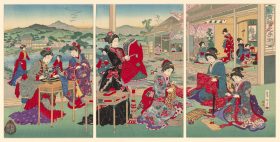A Transcore of the Radical Imaginatory at the Museum of Contemporary Art Australia (MCA) is the first major survey in Australia – indeed in the southern hemisphere – by Ethiopian American artist Julie Mehretu (b 1970).
She has been described as “one of today’s most original and thought-provoking painters” (The New York Times), and her CV is testament to that hype. Most recently, she was commissioned to create a 27-metre high glass artwork for the Obama Presidential Centre (opening 2025), and her 2019 exhibition across the Los Angeles County Museum of Art and Whitney Museum of American Art was highly celebrated.
So as a choice for the Sydney summer blockbuster season this exhibition seemed fitting. After all, Mehretu is no stranger to the MCA, having shown her work in the 15th Biennale of Sydney in 2006. The work has changed a lot since then.
And the proximity of that major American survey has, in many ways, shaped this exhibition. What Australian audiences will view are more than 80 works – 36 of those large-scale paintings – that have been completed since that show. Considered with that lens, one can start to see just how prolific Mehretu is in the studio.
Of particular note is a suite of nine black paintings titled, Femenine in nine (2023-2024) finished just in time for the MCA show, and the Art Gallery of NSW to acquire one. Named after the 1974 composition by African American, experimental musician Julius Eastman, these paintings are meditations on a darkness and instability that defines our contemporary world.

They are definitely brooding, only lifted by an iridescent purple haze or gesture. For this writer, however, they are not the highlight of the exhibition, and in some ways lack the energy and vibration within Mehretu’s earlier works that have built her reputation.
Increasingly, Mehretu has used more spray aerosol and stencil techniques, and this exhibition really dwells in that recent chapter, and perhaps doesn’t have the finesse or nuance of mark-making of the early works.
The highlight of the show are Mehretu’s TRANSpaintings (20223-2024), presented across two gallery spaces. They hover in space, held aloft by ‘Upright Brackets’, a term used by collaborator, Berlin-based sculptor Nairy Baghramian.
Viewers move in and around these pieces, which are created from polyester mesh, allowing for a translucency and play with light, so that the paintings appear illuminated from within.
The depth of field – those many layers that are signature to Mehretu – are caught and flattened into an almost architectural surface that one can walk around, each side of the painting different, but painted at the same time of making. Metaphorically this flip and shift of psyches and framing feel very apt for our times.
What I especially like about these pieces is that the architecture of the city, often references in the line and energy of her abstractions, is expanded to the presentation of the works. Seven of these are presented for the first time in Sydney.
A further highlight is the painting Black Monolith, for Okwui Enwezor (Charlottesville) (2017-2020), viewed early in the exhibition and which seemingly bridges her earlier paintings and later works. We see a lot more line here, and angular stencilled forms and direction lines, all floating in sub-layer upon sub-layer creating a visceral world.
Mehretu’s maximalist abstractions are built up with incalculable numbers of digital photographs (often blurred as the foundation to her paintings), architectural renderings, contemporary signs, ancient mark-making, utopianism of yesteryear, postcolonial thinking and a love of the graphic gesture, which are then compressed and collaged into a monumental expression.
The enormous painting Haka (and Riot) (2019) from the LACMA show and collection, is one such example, and is presented with the TRANSpaintings and offers a bridge, again, to past and present interests in the work.

Mehretu describes her making as cycles of painting, where there is that referential cycle across her oeuvre of making, while always escalating and moving forward. The exhibition attempts to flesh out some of these cycles – and to the viewer they read as a kind of ‘same same but different’, tutored as we move through to a visual language that shifts only in intensity or palette.
Adding further grounding to understanding her oeuvre are 50 etchings, drawings and works on paper stretching back to the mid 1990s, and completing the exhibition. A standout piece is This Manifestation of Historical Restlessness (from Robin’s Intimacy), (2022) a 10-panel etching with aquatint. It is a great example of how you can create scale and impact in the print medium.
I would have liked to have seen some extended wall labels for some of the key works in this exhibition. Given that they often are based on specific political, environmental or social moments in time, which are triggers for their emotional gestures, it would have helped audiences from this region – experiencing her work for a first time – to find greater connection.
Read: Exhibition review: Magritte, Art Gallery of NSW
While some of the newer works feel as if they have tipped over into a more graffiti genre, and have been overworked causing their depth to become compressed, and a level of intimacy lost, in the haze of the air brush and stencil work, overall the exhibition does present the complexity of Mehretu’s multi-decade practice.
For anyone interested in abstraction and expanded painting in our times, the exhibition remains a good one to ponder contemporary concerns and trends. There is a kinetic quality within her monumental abstractions, and it is this palpable buzz that moves her work away from mere non-representational painting to an expression of our enfolding epoch.
Julie Mehretu: A Transcore of the Radical Imaginatory
Co-curated by Suzanne Cotter and Jane Devery
Museum of Contemporary Art Australia
Sydney International Art Series 2024-2025
29 November – 27 April 2025
Ticketed





_Encounters-in-Reflection_Gallery3BPhoto-by-Anpis-Wang-e1745414770771.jpg?w=280)